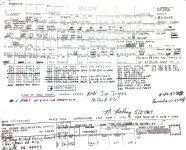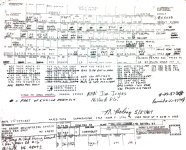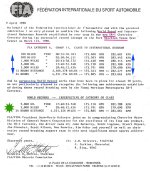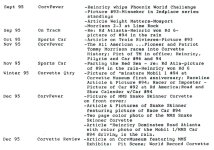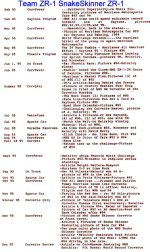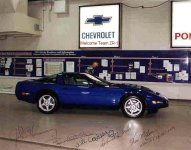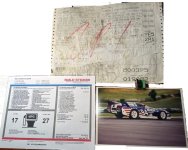teamzr1
Supporting vendor
In 1987, rumors of an all-new, high performance Corvette built upon the fourth generation platform began circulating among the automotive press.
Dubbed the “King of the Hill,” the secretive supercar was said to be a world-beater, and in March of 1989, GM debuted its impressive Corvette ZR-1 at the Geneva Motor Show.
This year marks the 25th anniversary of the ZR-1’s market debut, and while a mere 6,939 were ever built, the car remains a memorable piece of Corvette history, as well as a bridge from performance Corvettes past to the present.
The 1990 car didn’t originate the ZR1 moniker (though it did originate the hyphenated ZR-1 name). From 1970 to 1972, Chevrolet offered an RPO ZR1 option for the Corvette that included a 350-cu.in., 370-horsepower V-8 mated to a close-ration four-speed transmission; heavy-duty brakes; a transistorized ignition; an aluminum radiator; and a heavy-duty suspension.
Wisely, the configuration was not recommended for street driving, but those opting to exercise their Stingrays in a closed-course environment surely saw the benefits of this package.
When the fourth-generation Corvette made its appearance for the 1984 model year, the car’s handling won near-universal praise.
Its 205-horsepower 350-cu.in. V-8, however, did not, and within a few years of launch the car’s underwhelming performance began to have an impact on sales. GM had been working on an in-house performance engine option of its own, but building one that maintained the civility needed for everyday driving proved challenging.
Enter partner Lotus Group, which GM had acquired in a 1985 deal. Working in conjunction with the Chevrolet, Pontiac, GM Canada (CPC) Division, Lotus developed an aluminum-block 350 V-8 that utilized double overhead camshafts and four valves per cylinder and proved capable of producing 375 horsepower and 370 pound-feet of torque.
It was the testing of this engine (a variant of which would appear in the 1986 Corvette Indy concept) that led to the rumors of a “King of the Hill” Corvette, and in March of 1989, GM was ready to show its hand.
The Geneva debut was hardly accidental, and GM made sure to invite press from around the globe for the car’s European test drive.
Most media outlets wasted no time heaping praise on the car, which proved capable of running from 0-60 MPH in a little over four seconds, on its way to a top speed of 175 MPH. Car and Driver even called it “The Corvette from Hell” for its performance potential, and as if to illustrate that the ZR-1 would not suffer fools behind the wheel, a horsepower-limiting valet lockout was standard equipment.
In addition to the Lotus-designed V-8 beneath the hood, the ZR-1 featured a three-inch wider rear track, necessitated by its oversize 315/35-17 rear tires (which humbled the base Corvette’s 275/40-17 rear skins).
The change required new doors, as well as a new rear fascia that took a convex shape to distinguish it from lesser Corvettes (for the 1990 model year, anyway). Taillamps on ZR-1 models were rectangular in shape, but in profile, the ZR-1 looked very much like a base model Corvette, albeit one with different wheels.
Neither GM nor Lotus had the ability to construct the ZR-1’s LT5 V-8 in sufficient quantities, so production of the hand-built engine was awarded to Mercury Marine in Stillwater, Oklahoma.
Assembly proved costly, as did the significant changes to the Corvette’s body to accommodate the ZR-1 changes, and the car was priced accordingly.
In 1990, a base model Corvette could be purchased for $31,979, yet the cost of the ZR-1 package alone added another $27,015 (or nearly 84.5-percent of sticker price) to the car’s label.
Despite this, and despite dealer markups that reportedly doubled the price, initial demand was respectable
To allay fears that the ZR-1’s aluminum engine lacked durability, a production model was pulled from the assembly line in the spring of 1990 and sent to a proving ground in Fort Stockton, Texas.
There, the Corvette proceeded to set a series of speed and endurance records, covering 5,000 kilometers at an average speed of 175.71 MPH; 5,000 miles at an average speed of 173.29 MPH; and running for 24 hours at an average speed of 175.88 MPH, covering over 4,200 miles in the process.
For the 1990 model year, GM built 3,049 examples, followed by 2,044 in 1991; 502 in 1992; and 448 each year from 1993 to 1995, when ZR-1 production ended.
Even a bump in output to 405-horsepower for the 1993 model year failed to reverse falling sales, but increasing horsepower in other Corvette models was also to blame.
A new LT-1 V-8, introduced for the 1992 model year, made 300 horsepower and 330 pound-feet of torque, making the argument for spending an addition $31,683 (the ZR-1’s package price in 1992) that much harder to justify.
Dubbed the “King of the Hill,” the secretive supercar was said to be a world-beater, and in March of 1989, GM debuted its impressive Corvette ZR-1 at the Geneva Motor Show.
This year marks the 25th anniversary of the ZR-1’s market debut, and while a mere 6,939 were ever built, the car remains a memorable piece of Corvette history, as well as a bridge from performance Corvettes past to the present.
The 1990 car didn’t originate the ZR1 moniker (though it did originate the hyphenated ZR-1 name). From 1970 to 1972, Chevrolet offered an RPO ZR1 option for the Corvette that included a 350-cu.in., 370-horsepower V-8 mated to a close-ration four-speed transmission; heavy-duty brakes; a transistorized ignition; an aluminum radiator; and a heavy-duty suspension.
Wisely, the configuration was not recommended for street driving, but those opting to exercise their Stingrays in a closed-course environment surely saw the benefits of this package.
When the fourth-generation Corvette made its appearance for the 1984 model year, the car’s handling won near-universal praise.
Its 205-horsepower 350-cu.in. V-8, however, did not, and within a few years of launch the car’s underwhelming performance began to have an impact on sales. GM had been working on an in-house performance engine option of its own, but building one that maintained the civility needed for everyday driving proved challenging.
Enter partner Lotus Group, which GM had acquired in a 1985 deal. Working in conjunction with the Chevrolet, Pontiac, GM Canada (CPC) Division, Lotus developed an aluminum-block 350 V-8 that utilized double overhead camshafts and four valves per cylinder and proved capable of producing 375 horsepower and 370 pound-feet of torque.
It was the testing of this engine (a variant of which would appear in the 1986 Corvette Indy concept) that led to the rumors of a “King of the Hill” Corvette, and in March of 1989, GM was ready to show its hand.
The Geneva debut was hardly accidental, and GM made sure to invite press from around the globe for the car’s European test drive.
Most media outlets wasted no time heaping praise on the car, which proved capable of running from 0-60 MPH in a little over four seconds, on its way to a top speed of 175 MPH. Car and Driver even called it “The Corvette from Hell” for its performance potential, and as if to illustrate that the ZR-1 would not suffer fools behind the wheel, a horsepower-limiting valet lockout was standard equipment.
In addition to the Lotus-designed V-8 beneath the hood, the ZR-1 featured a three-inch wider rear track, necessitated by its oversize 315/35-17 rear tires (which humbled the base Corvette’s 275/40-17 rear skins).
The change required new doors, as well as a new rear fascia that took a convex shape to distinguish it from lesser Corvettes (for the 1990 model year, anyway). Taillamps on ZR-1 models were rectangular in shape, but in profile, the ZR-1 looked very much like a base model Corvette, albeit one with different wheels.
Neither GM nor Lotus had the ability to construct the ZR-1’s LT5 V-8 in sufficient quantities, so production of the hand-built engine was awarded to Mercury Marine in Stillwater, Oklahoma.
Assembly proved costly, as did the significant changes to the Corvette’s body to accommodate the ZR-1 changes, and the car was priced accordingly.
In 1990, a base model Corvette could be purchased for $31,979, yet the cost of the ZR-1 package alone added another $27,015 (or nearly 84.5-percent of sticker price) to the car’s label.
Despite this, and despite dealer markups that reportedly doubled the price, initial demand was respectable
To allay fears that the ZR-1’s aluminum engine lacked durability, a production model was pulled from the assembly line in the spring of 1990 and sent to a proving ground in Fort Stockton, Texas.
There, the Corvette proceeded to set a series of speed and endurance records, covering 5,000 kilometers at an average speed of 175.71 MPH; 5,000 miles at an average speed of 173.29 MPH; and running for 24 hours at an average speed of 175.88 MPH, covering over 4,200 miles in the process.
For the 1990 model year, GM built 3,049 examples, followed by 2,044 in 1991; 502 in 1992; and 448 each year from 1993 to 1995, when ZR-1 production ended.
Even a bump in output to 405-horsepower for the 1993 model year failed to reverse falling sales, but increasing horsepower in other Corvette models was also to blame.
A new LT-1 V-8, introduced for the 1992 model year, made 300 horsepower and 330 pound-feet of torque, making the argument for spending an addition $31,683 (the ZR-1’s package price in 1992) that much harder to justify.

